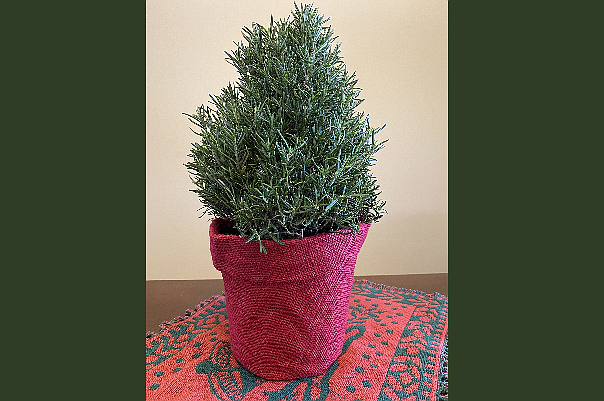Add a Rosemary Topiary to This Year’s Holiday Season
November 29, 2023 at 8:00 p.m.
Add a fresh look and fragrance to your holidays with a potted Rosemary plant. This favorite herb of cooks, crafters, and gardeners can be sheared into the shape of a wreath, small tree or orb and found at garden centers and florists.
The pine scent and attractive foliage make it a wonderful addition to the holidays. It adds nice color, texture, and fragrance to any room or holiday decor. Add a bow and decorative pot for the perfect hostess or holiday gift.
Rosemary was as popular a Christmas plant as mistletoe and holly until the 20th Century. It’s not clear why this plant fell out of favor. Whatever the reason it has not stopped Rosemary from making a big comeback for the holidays.
Rosemary represents love and remembrance, a great sentiment to share during the holidays. Give the plant a pet and the aroma that follows is sure to lift your spirits. Or pluck a sprig to add welcome flavor to your winter meals and beverages. Then move it outdoors in the garden when the danger of frost has passed.
Regular trimming will help maintain its topiary form and keep the plant producing more stems and leaves for a fuller, more robust plant. Prune back or remove overgrown or wayward branches to maintain the desired shape. Remove and use the leaves on these long stems, then turn them into skewers for cooking kabobs. Use trimmings from the tender stem tips and leaves to flavor your holiday meals or mix a few of these into your holiday centerpieces and wreaths.
Keeping Rosemary plants alive and looking their best throughout the winter can be challenging. Grow it in a cool location with bright light to boost your success. Use artificial lights if natural light is limited.
Avoid drafts of hot and cold air. Water your plant thoroughly but only when the soil is just starting to dry. Allowing the soil to go too dry or keeping it too wet will result in the death of your plant. Pour off any excess water that collects in the saucer. Or place pebbles or marbles in the saucer to elevate the pot above any excess water.
Skip the fertilizer since most plants are experiencing limited growth during winter. Begin fertilizing as needed once the days lengthen and the plants are actively growing in spring.
And if your plant dies, stick it in a corner out of sight, but within reach. A gentle petting of even a dead Rosemary plant will still release a wonderful fragrance for you to enjoy.
Rosemary (Rosmarinus officinalis) is a Mediterranean native and hardy to zone 8. This evergreen perennial herb grows 4 to 6 feet tall outdoors in zones 8 and warmer. There are a few cultivars like Alcalde Cold Hardy, Arp, Athens Blue Spire, and Madeline Hill that are supposed to be hardy to zone 6.
You may have discovered, or others have told you that growing Rosemary indoors can be challenging. Don’t let past failures stop you from trying. Just keep trying until you find the location and maintenance routine that keeps your Rosemary thriving under your care. Then consider drying and preserving some of the Rosemary for cooking or gifting to friends and family.
Melinda Myers has written more than 20 gardening books, including the recently released Midwest Gardener’s Handbook, 2nd Edition and Small Space Gardening. She hosts The Great Courses “How to Grow Anything” instant video and DVD series and the nationally syndicated Melinda’s Garden Moment TV & radio program. Myers is a columnist and contributing editor for Birds & Blooms magazine. Myers’ website is www.MelindaMyers.com.





